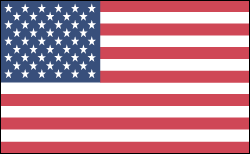United States
 President: George W. Bush (2001) Vice President: Richard B. Cheney (2001) Land area: 3,539,225 sq mi (9,166,601 sq km); total area: 3,718,691 sq mi (9,631,420 sq km) Population (2007 est.): 301,139,947 (growth rate: 0.9%); birth rate: 14.2/1000; infant mortality rate: 6.4/1000; life expectancy: 78.0; density per sq mi: 85 Capital (2003 est.): Washington, DC, 570,898 Largest cities (2003 est.): New York, 18,498,000 (metro area), 8,085,742 (city proper); Los Angeles, 12,146,000 (metro area), 3,819,951 (city proper); Chicago, 8,711,000 (metro area), 2,869,121 (city proper); Houston, 2,009,960; Philadelphia, 1,479,339; Phoenix, 1,388,416; San Diego, 1,226,753; San Antonio, 1,214,725; Dallas, 1,208,318; Detroit, 911,402 Monetary unit: dollar Languages: English 82%, Spanish 11% (2000) Ethnicity/race: White: 211,460,626 (75.1%); Black: 34,658,190 (12.3%); Asian: 10,242,998 (3.6%); American Indian and Alaska Native: 2,475,956 (0.9%); Native Hawaiian and other Pacific Islander: 398,835 (0.1%); other race: 15,359,073 (5.5%); Hispanic origin:1 35,305,818 (12.5%) Religions: Protestant 52%, Roman Catholic 24%, Mormon 2%, Jewish 1%, Muslim 1%, none 10% (2002) Literacy rate: 97% (1979 est.) Economic summary: GDP/PPP (2005 est.): $12.41 trillion; per capita $42,000. Real growth rate: 3.5%. Inflation: 3.2%. Unemployment: 5.1%. Arable land: 18%. Agriculture: wheat, corn, other grains, fruits, vegetables, cotton; beef, pork, poultry, dairy products; fish; forest products. Labor force: 149.3 million (includes unemployed); farming, forestry, and fishing 0.7%, manufacturing, extraction, transportation, and crafts 22.9%, managerial, professional, and technical 34.7%, sales and office 25.4%, other services 16.3%; note: figures exclude the unemployed (2005). Industries: leading industrial power in the world, highly diversified and technologically advanced; petroleum, steel, motor vehicles, aerospace, telecommunications, chemicals, electronics, food processing, consumer goods, lumber, mining. Natural resources: coal, copper, lead, molybdenum, phosphates, uranium, bauxite, gold, iron, mercury, nickel, potash, silver, tungsten, zinc, petroleum, natural gas, timber. Exports: $927.5 billion f.o.b. (2005 est.): agricultural products 9.2% (soybeans, fruit, corn), industrial supplies 26.8% (organic chemicals), capital goods 49.0% (transistors, aircraft, motor vehicle parts, computers, telecommunications equipment), consumer goods 15.0% (automobiles, medicines) (2003). Imports: $1.727 trillion f.o.b. (2005 est.): agricultural products 4.9%, industrial supplies 32.9% (crude oil 8.2%), capital goods 30.4% (computers, telecommunications equipment, motor vehicle parts, office machines, electric power machinery), consumer goods 31.8% (automobiles, clothing, medicines, furniture, toys) (2003). Major trading partners: Canada, Mexico, Japan, UK, China, Germany (2004). Communications: Telephones: main lines in use: 194 million (1997); mobile cellular: 69.209 million (1998). Radio broadcast stations: AM about 5,000, FM about 5,000, shortwave 18 (1998). Radios: 575 million (1997). Television broadcast stations: more than 1,500 (including nearly 1,000 stations affiliated with the five major networks—NBC, ABC, CBS, FOX, and PBS; in addition, there are about 9,000 cable TV systems) (1997). Televisions: 219 million (1997). Internet Service Providers (ISPs): 7,000 (2002 est.). Internet users: 165.75 million (2002). Transportation: Railways: total: 194,731 km mainline routes (2000). Highways: total: 6,334,859 km; paved: 3,737,567 km (including 89,426 km of expressways); unpaved: 2,597,292 km (2000). Waterways: 41,009 km of navigable inland channels, exclusive of the Great Lakes. Ports and harbors: Anchorage, Baltimore, Boston, Charleston, Chicago, Duluth, Hampton Roads, Honolulu, Houston, Jacksonville, Los Angeles, New Orleans, New York, Philadelphia, Port Canaveral, Portland (Oregon), Prudhoe Bay, San Francisco, Savannah, Seattle, Tampa, Toledo. Airports: 14,801 (2002). International disputes: prolonged drought in the Mexico border region has strained water-sharing arrangements; 1990 Maritime Boundary Agreement in the Bering Sea awaits Russian Duma ratification; maritime boundary disputes with Canada at Dixon Entrance, Beaufort Sea, Strait of Juan de Fuca, and around the disputed Machias Seal Island and North Rock; The Bahamas have not been able to agree on a maritime boundary; US Naval Base at Guantanamo Bay is leased from Cuba and only mutual agreement or US abandonment of the area can terminate the lease; Haiti claims Navassa Island; US has made no territorial claim in Antarctica (but has reserved the right to do so) and does not recognize the claims of any other state; Marshall Islands claims Wake Island. 1. Persons of Hispanic origin can be of any race. |
| |
Government
Federal republic.
The president is elected for a four-year term and may be reelected only once. The bicameral Congress consists of the 100-member Senate, elected to a six-year term with one-third of the seats becoming vacant every two years, and the 435-member House of Representatives, elected every two years. The minimum voting age is 18.
Hiç yorum yok:
Yorum Gönder